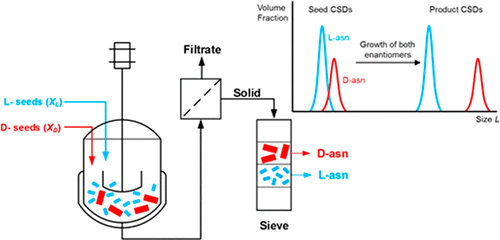当前位置:
X-MOL 学术
›
Cryst. Growth Des.
›
论文详情
Our official English website, www.x-mol.net, welcomes your
feedback! (Note: you will need to create a separate account there.)
Enabling Mechanical Separation of Enantiomers through Controlled Batchwise Concomitant Crystallization: Digital Design and Experimental Validation
Crystal Growth & Design ( IF 3.2 ) Pub Date : 2020-10-27 , DOI: 10.1021/acs.cgd.0c00974 Andrew S. Dunn 1, 2 , Botond Szilagyi 3 , Joop H. ter Horst 2, 4 , Zoltan K. Nagy 3, 5
Crystal Growth & Design ( IF 3.2 ) Pub Date : 2020-10-27 , DOI: 10.1021/acs.cgd.0c00974 Andrew S. Dunn 1, 2 , Botond Szilagyi 3 , Joop H. ter Horst 2, 4 , Zoltan K. Nagy 3, 5
Affiliation

|
In the pharmaceutical industry the separation of chiral molecules is important due to the different physiochemical properties that the enantiomers of a chiral drug possess. Therefore, resolution techniques are used to separate such enantiomers from one another. In particular, preferential crystallization is a common technique used to separate conglomerate-forming compounds, due to its high selectivity. However, the efficient separation of enantiomers in a batchwise preferential crystallization process through seeding with the preferred enantiomer alone is still inefficient, since unwanted nucleation of the counter enantiomer is inevitable. Here, we demonstrate a model-based digital design for the separation of enantiomers for a conglomerate-forming compound (asparagine monohydrate), by using mechanical separation by sieving after crystallization, whereby the separation is enabled by a designed bias in the crystal size distributions of each enantiomer. This bias is created by a concomitant crystallization of both enantiomers using optimized seeding and cooling profiles obtained from a population balance model. In this way, a high level of control is achieved over a batchwise preferential crystallization process, since the crystallization of both enantiomers is controlled. We show that, through this separation method, material with impurity levels as low as 6 wt % can be obtained. To our knowledge this is the first demonstration of modeling such a process to separate enantiomers of a conglomerate-forming compound.
中文翻译:

通过控制的分批伴随结晶使对映异构体机械分离:数字设计和实验验证
在制药工业中,由于手性药物的对映异构体具有不同的物理化学性质,手性分子的分离很重要。因此,使用拆分技术将此类对映异构体彼此分离。特别地,由于其高选择性,优先结晶是用于分离形成团块的化合物的常用技术。但是,由于优选的对映体的不希望的成核是不可避免的,因此通过单独用优选的对映体进行晶种在分批优先结晶过程中对映体的有效分离仍然是无效的。在这里,我们展示了基于模型的数字设计,该模型用于通过结晶后筛分的机械分离来分离形成团块的化合物(一水天冬酰胺)的对映异构体,由此,通过设计上的各对映异构体的晶体尺寸分布的偏差来实现分离。使用从种群平衡模型获得的优化的晶种和冷却曲线,两种对映异构体的同时结晶会产生这种偏差。以这种方式,由于两种对映异构体的结晶均得到控制,因此在分批优先结晶过程中实现了高水平的控制。我们表明,通过这种分离方法,可以获得杂质含量低至6 wt%的材料。据我们所知,这是对将聚集物形成化合物的对映异构体进行分离的这一过程进行建模的第一个证明。使用从种群平衡模型获得的优化的晶种和冷却曲线,两种对映异构体的同时结晶会产生这种偏差。以这种方式,由于两种对映异构体的结晶均得到控制,因此在分批优先结晶过程中实现了高水平的控制。我们表明,通过这种分离方法,可以获得杂质含量低至6 wt%的材料。据我们所知,这是对将聚集物形成化合物的对映异构体进行分离的这一过程进行建模的第一个证明。使用从种群平衡模型获得的优化的晶种和冷却曲线,两种对映异构体的同时结晶会产生这种偏差。以这种方式,由于两种对映异构体的结晶均得到控制,因此在分批优先结晶过程中实现了高水平的控制。我们表明,通过这种分离方法,可以获得杂质含量低至6 wt%的材料。就我们所知,这是对将聚集物形成化合物的对映异构体进行分离的这一过程进行建模的第一个证明。通过这种分离方法,可以获得杂质含量低至6重量%的材料。据我们所知,这是对将聚集物形成化合物的对映异构体进行分离的这一过程进行建模的第一个证明。通过这种分离方法,可以获得杂质含量低至6重量%的材料。就我们所知,这是对将聚集物形成化合物的对映异构体进行分离的这一过程进行建模的第一个证明。
更新日期:2020-12-02
中文翻译:

通过控制的分批伴随结晶使对映异构体机械分离:数字设计和实验验证
在制药工业中,由于手性药物的对映异构体具有不同的物理化学性质,手性分子的分离很重要。因此,使用拆分技术将此类对映异构体彼此分离。特别地,由于其高选择性,优先结晶是用于分离形成团块的化合物的常用技术。但是,由于优选的对映体的不希望的成核是不可避免的,因此通过单独用优选的对映体进行晶种在分批优先结晶过程中对映体的有效分离仍然是无效的。在这里,我们展示了基于模型的数字设计,该模型用于通过结晶后筛分的机械分离来分离形成团块的化合物(一水天冬酰胺)的对映异构体,由此,通过设计上的各对映异构体的晶体尺寸分布的偏差来实现分离。使用从种群平衡模型获得的优化的晶种和冷却曲线,两种对映异构体的同时结晶会产生这种偏差。以这种方式,由于两种对映异构体的结晶均得到控制,因此在分批优先结晶过程中实现了高水平的控制。我们表明,通过这种分离方法,可以获得杂质含量低至6 wt%的材料。据我们所知,这是对将聚集物形成化合物的对映异构体进行分离的这一过程进行建模的第一个证明。使用从种群平衡模型获得的优化的晶种和冷却曲线,两种对映异构体的同时结晶会产生这种偏差。以这种方式,由于两种对映异构体的结晶均得到控制,因此在分批优先结晶过程中实现了高水平的控制。我们表明,通过这种分离方法,可以获得杂质含量低至6 wt%的材料。据我们所知,这是对将聚集物形成化合物的对映异构体进行分离的这一过程进行建模的第一个证明。使用从种群平衡模型获得的优化的晶种和冷却曲线,两种对映异构体的同时结晶会产生这种偏差。以这种方式,由于两种对映异构体的结晶均得到控制,因此在分批优先结晶过程中实现了高水平的控制。我们表明,通过这种分离方法,可以获得杂质含量低至6 wt%的材料。就我们所知,这是对将聚集物形成化合物的对映异构体进行分离的这一过程进行建模的第一个证明。通过这种分离方法,可以获得杂质含量低至6重量%的材料。据我们所知,这是对将聚集物形成化合物的对映异构体进行分离的这一过程进行建模的第一个证明。通过这种分离方法,可以获得杂质含量低至6重量%的材料。就我们所知,这是对将聚集物形成化合物的对映异构体进行分离的这一过程进行建模的第一个证明。











































 京公网安备 11010802027423号
京公网安备 11010802027423号